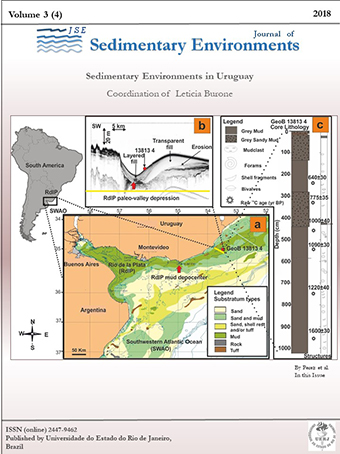RELATIONSHIPS BETWEEN THE SAND CYCLE AND THE BEHAVIOUR OF SMALL RIVER MOUTHS: A NEGLECTED PROCESS
DOI:
https://doi.org/10.12957/jse.2018.39307Keywords:
Sand cycle. Sedimentary balance. Aeolian transport. Outlets-beach interaction. Human intervention. Río de la Plata estuary. / Palavras-chave, Ciclo de areia. Equilíbrio sedimentar. Transporte eólico. Interação estuários-praia. Intervenção humana. EstuárioAbstract
This article aims to advance in the knowledge of the relationships between the sand cycle and the behaviour of small river mouths (outlets) flowing into sandy beaches in the Río de la Plata estuary, Uruguay. The bars of these watercourses respond quickly with processes of erosion and/or migration of the channel when the "sand cycle" (coastal sedimentary balance) undergoes modifications, due to i) the effect of the fixation of dunes (sediments) by afforestation with exotic species and ii) the construction of infrastructure. Two watercourses were analysed: the Pando River and the Carrasco Creek that both have received different impacts and suffered modifications, not only in the sediment flow but also in their hydrological regime. A multitemporal analysis was based on a series of aerial photos and cartography since 1928, a background review, and the support of documents and chronicles. The data obtained were analysed statistically. Results evidence a significant loss of beach surface at the Pando River mouth, and an increase at the Carrasco Creek mouth, since the channelling of a wetland located upstream, allowing the entrance of sediments from the basin upstream of the wetland. Relevant outcomes are: i) the description and analysis of the relationships established between dune systems and the outlets of the watercourses, an aspect that has not received due attention in the scientific literature, in which the dissociation between the analysis of wind and fluvial dynamics is usual, and ii) the sedimentary balance was of both systems: erosion and accretion at the Pando and the Carrasco outlets respectively. The reconstruction of the dunes could likely prevent the escape of sand and reduce the erosion. The knowledge about human intervention and natural processes governing the interactions between sandy beaches, dunes and outlets is a crucial input to coastal management and adaptation to sea-level rise and storm surges.
Resumo
Este artigo tem como objetivo contribuir para o conhecimento das relações entre o ciclo de areia e o comportamento da foz de rios pequenos que desaguam em praias arenosas no estuário do Río de la Plata, no Uruguai. As barras destes cursos de água respondem rapidamente a processos de erosão e / ou migração do canal quando o "ciclo de areia" (equilíbrio sedimentar costeiro) sofre modificações, devido: i) ao efeito da fixação de dunas (sedimentos) por reflorestamento com espécies exóticas e; ii) á construção de infra-estruturas. Foram analisados dois cursos de água: os rios Pando e Carrasco, que receberam impactos diferentes e sofreram modificações, não apenas no fluxo de sedimentos, mas também no regime hidrológico. Foi efetuada a análise temporal de uma série de fotos aéreas e cartografia desde 1928, a revisão da bibliografia e utilizado suporte documental e crônicas. Os dados obtidos foram analisados estatisticamente. Os resultados evidenciam perda significativa da extensão da praia na foz do rio Pando, e um aumento da extensão na foz do rio Carrasco, desde a canalização de uma zona úmida localizada a montante, permitindo a entrada de sedimentos da bacia a montante do pantanal. Os resultados adquiridos mais relevantes foram: i) a descrição e análise das relações estabelecidas entre os sistemas dunares e os fluxos dos cursos d'água, aspecto que não tem recebido a devida atenção na literatura científica, em que a dissociação entre a análise da dinâmica eólica e fluvial é usual, e ii) o balanço sedimentar de ambos os sistemas: erosão e acreção na embocadura dos rios Pando e Carrasco, respectivamente. A reconstrução das dunas poderia evitar a perda de areia e reduzir a erosão. O conhecimento sobre intervenção humana e processos naturais que regem as interações entre praias arenosas, dunas e estuários é um conhecimento crucial para o gerenciamento costeiro e a adaptação à elevação do nível do mar e às tempestades.
Downloads
Published
Issue
Section
License

Journal of Sedimentary Environments (JSE) is licensed under a Creative Commons Attribution-Noncommercial-Share Alike 4.0 International License.

